I don't think I ever posted the results of my DNA swab, as described here. Briefly, the National Geographic Society is conducting a rather large study, attempting to map out human history via DNA swabs. Comparatively wealthy citizens of the world pay $100 for their samples, in order to underwrite the collection efforts for less wealthy areas of the world.
Unfortunately, the cool stuff is a Flash file, hidden for participants only, including art samples of Upper Paleolithic man, explanation of the migration to England which my ancestors apparently did, etc. Very cool stuff. Here is what I've managed to extract.
How to Interpret Your Results Above are results from the laboratory analysis of your Y-chromosome. Your DNA was analyzed for Short Tandem Repeats (STRs), which are repeating segments of your genome that have a high mutation rate. The location on the Y chromosome of each of these markers is depicted in the image, with the number of repeats for each of your STRs presented to the right of the marker. For example, DYS19 is a repeat of TAGA, so if your DNA repeated that sequence 12 times at that location, it would appear: DYS19 12. Studying the combination of these STR lengths in your Y Chromosome allows researchers to place you in a haplogroup, which reveals the complex migratory journeys of your ancestors. Y-SNP: In the event that the analysis of your STRs was inconclusive, your Y chromosome was also tested for the presence of an informative Single Nucleotide Polymorphism (SNP). These are mutational changes in a single nucleotide base, and allow researchers to definitively place you in a genetic haplogroup.Entire migratory history below 'the fold'. Some of it is beyond my understanding, but it is still fascinating.
Your Y chromosome results identify you as a member of haplogroup R1b, a lineage defined by a genetic marker called M343. This haplogroup is the final destination of a genetic journey that began some 60,000 years ago with an ancient Y chromosome marker called M168.
The very widely dispersed M168 marker can be traced to a single individual--"Eurasian Adam." This African man, who lived some 31,000 to 79,000 years ago, is the common ancestor of every non-African person living today. His descendants migrated out of Africa and became the only lineage to survive away from humanity's home continent.Population growth during the Upper Paleolithic era may have spurred the M168 lineage to seek new hunting grounds for the plains animals crucial to their survival. A period of moist and favorable climate had expanded the ranges of such animals at this time, so these nomadic peoples may have simply followed their food source.
Improved tools and rudimentary art appeared during this same epoch, suggesting significant mental and behavioral changes. These shifts may have been spurred by a genetic mutation that gave "Eurasian Adam's" descendants a cognitive advantage over other contemporary, but now extinct, human lineages.
Some 90 to 95 percent of all non-Africans are descendants of the second great human migration out of Africa, which is defined by the marker M89.
M89 first appeared 45,000 years ago in Northern Africa or the Middle East. It arose on the original lineage (M168) of "Eurasian Adam," and defines a large inland migration of hunters who followed expanding grasslands and plentiful game to the Middle East.
Many people of this lineage remained in the Middle East, but others continued their movement and followed the grasslands through Iran to the vast steppes of Central Asia. Herds of buffalo, antelope, woolly mammoths, and other game probably enticed them to explore new grasslands.
With much of Earth's water frozen in massive ice sheets, the era's vast steppes stretched from eastern France to Korea. The grassland hunters of the M89 lineage traveled both east and west along this steppe "superhighway" and eventually peopled much of the continent.
A group of M89 descendants moved north from the Middle East to Anatolia and the Balkans, trading familiar grasslands for forests and high country. Though their numbers were likely small, genetic traces of their journey are still found today.
Some 40,000 years ago a man in Iran or southern Central Asia was born with a unique genetic marker known as M9, which marked a new lineage diverging from the M89 group. His descendants spent the next 30,000 years populating much of the planet.
Most residents of the Northern Hemisphere trace their roots to this unique individual, and carry his defining marker. Nearly all North Americans and East Asians have the M9 marker, as do most Europeans and many Indians. The haplogroup defined by M9, K, is known as the Eurasian Clan.
This large lineage dispersed gradually. Seasoned hunters followed the herds ever eastward, along a vast belt of Eurasian steppe, until the massive mountain ranges of south central Asia blocked their path.
The Hindu Kush, Tian Shan, and Himalaya, even more formidable during the era's ice age, divided eastward migrations. These migrations through the "Pamir Knot" region would subsequently become defined by additional genetic markers.
The marker M45 first appeared about 35,000 to 40,000 years ago in a man who became the common ancestor of most Europeans and nearly all Native Americans. This unique individual was part of the M9 lineage, which was moving to the north of the mountainous Hindu Kush and onto the game-rich steppes of Kazakhstan, Uzbekistan, and southern Siberia.
The M45 lineage survived on these northern steppes even in the frigid Ice Age climate. While big game was plentiful, these resourceful hunters had to adapt their behavior to an increasingly hostile environment. They erected animal skin shelters and sewed weathertight clothing. They also refined the flint heads on their weapons to compensate for the scarcity of obsidian and other materials.
The intelligence that allowed this lineage to adapt and thrive in harsh conditions was critical to human survival in a region where no other hominids are known to have survived.
Members of haplogroup R are descendents of Europe's first large-scale human settlers. The lineage is defined by Y chromosome marker M173, which shows a westward journey of M45-carrying Central Asian steppe hunters.
The descendents of M173 arrived in Europe around 35,000 years ago and immediately began to make their own dramatic mark on the continent. Famous cave paintings, like those of Lascaux and Chauvet, signal the sudden arrival of humans with artistic skill. There are no artistic precedents or precursors to their appearance.
Soon after this lineage's arrival in Europe, the era of the Neandertals came to a close. Genetic evidence proves that these hominids were not human ancestors but an evolutionary dead end. Smarter, more resourceful human descendents of M173 likely outcompeted Neandertals for scarce Ice Age resources and thus heralded their demise.
The long journey of this lineage was further shaped by the preponderance of ice at this time. Humans were forced to southern refuges in Spain, Italy, and the Balkans. Years later, as the ice retreated, they moved north out of these isolated refuges and left an enduring, concentrated trail of the M173 marker in their wake.
Today, for example, the marker's frequency remains very high in northern France and the British Isles--where it was carried by M173 descendents who had weathered the Ice Age in Spain.
Members of haplogroup R1b, defined by M343 are the direct descendents of Europe's first modern humans--known as the Cro-Magnon people.
Cro-Magnons arrived in Europe some 35,000 years ago, during a time when Neandertals still lived in the region. M343-carrying peoples made woven clothing and constructed huts to withstand the frigid climes of the Upper Paleolithic era. They used relatively advanced tools of stone, bone, and ivory. Jewelry, carvings, and intricate, colorful cave paintings bear witness to the Cro Magnons' surprisingly advanced culture during the last glacial age.
When the ice retreated genetically homogenous groups recolonized the north, where they are still found in high frequencies. Some 70 percent of men in southern England are R1b. In parts of Spain and Ireland that number exceeds 90 percent.
There are many sublineages within R1b that are yet to be defined. The Genographic Project hopes to bring future clarity to the disparate parts of this distinctive European lineage.
Tags: Devolution, /DNA, /evolution
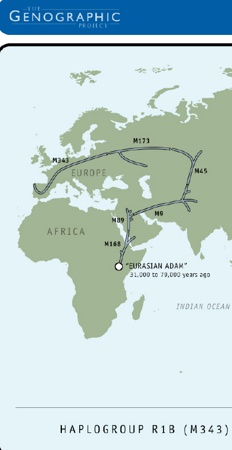
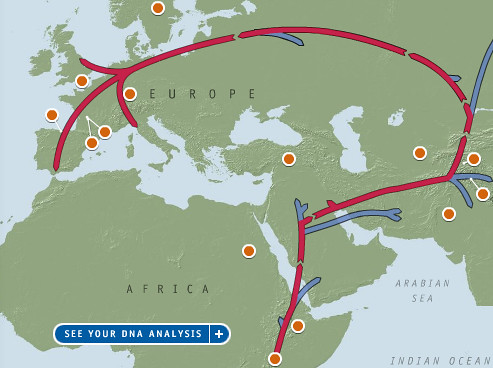

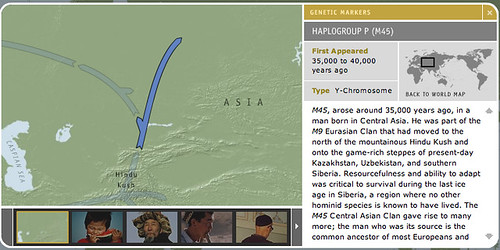
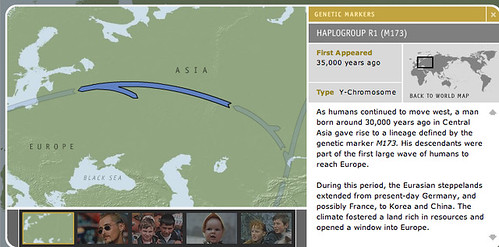
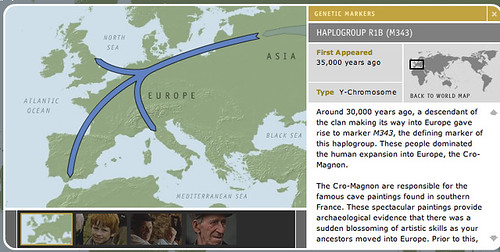
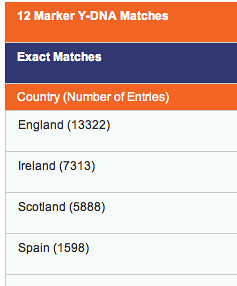
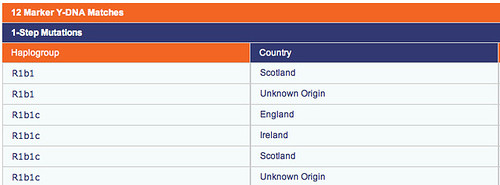

I thought about doing that swab test, but worried my DNA line would go back to a Pennsylvania trailer park and stop there.
A side effect has been that I've received several inquiries about my more recent ancestry (which I can only offer vague responses too, as my paternal grandfather was adopted, and I never knew my biological father at all).
I just had my Dad tested with National Geographic and you have the same Haplogroup and markers as he1 What does this mean, that somehow we are related thousands of years ago?
Hiya Cuz!
I just had my Dad tested with National Geographic and you have the same Haplogroup and markers as he1 What does this mean, that somehow we are related thousands of years ago?
Hiya Cuz!
Well I tested with National Geographic two years ago, I got the answer I'm R1b, then I tried to classify into the subclades but I'm pretty unsure if I'm right I do think my genoma is R1bc8, is there anyone who knows if there's a site with the classification of the subclades?
I am a descendant of frogs and spacemen, too.